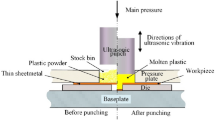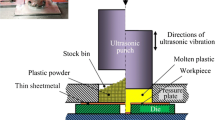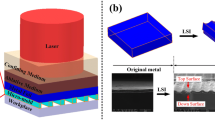Abstract
Micro-ultrasonic sheet-metal forming using molten plastic as a flexible punch is a new microforming technology useful for manufacturing micro-stamped thin sheet metals. In this paper, we researched how time parameters influenced the forming replication ability of microchannel forming. Our experimental results show that the forming replication ability of the method was improved by extending the ultrasonic action duration time and maintaining pressure time. An appropriate ultrasonic action duration time was determined by assessing the melting time of the plastic powder used as a flexible punch; an appropriate maintaining pressure time was determined by assessing the coagulation time of the molten plastic punch. When the ultrasonic action duration time was 0.5 s and the maintaining pressure time was 1.5 s, the forming replication ability of the microchannel reached 97 %. With further increases in the time parameters, the forming replication ability stopped rising, and the forming method produced parts with defects at a lower forming efficiency. Through these experiments, we obtained a set of optimal process parameters for microchannel formation.
Similar content being viewed by others
References
Fu MW, Chan WL (2013) A review on the state-of-the-art microforming technologies. Int J Adv Manuf Technol 67:2411–2437
Qin Y, Brockett A, Ma Y, Razali A, Zhao J, Harrison C, Pan W, Dai X, Loziak D (2010) Micro-manufacturing: research, technology outcomes and development issues. Int J Adv Manuf Technol 47:821–837
Brousseau EB, Dimov SS, Pham DT (2010) Some recent advances in multi-material micro- and nano-manufacturing. Int J Adv Manuf Technol 47:161–180
Manabe K, Shimizu T, Koyama H, Yang M, Ito K (2008) Validation of FE simulation based on surface roughness model in micro-deep drawing. J Mater Process Technol 204:89–93
Shimizu T, Ogawa M, Yang M, Manabe K (2014) Plastic anisotropy of ultra-thin rolled phosphor bronze foils and its thickness strain evolution in micro-deep drawing. Mater Des 56:604–612
Behrens G, Ruhe M, Tetzel H, Vollertsen F (2015) Effect of tool geometry variations on the punch force in micro deep drawing of rectangular components. Prod Eng Res Dev 9:195–201
Hu ZY (2011) Realisation and application of size dependent FEM-simulation for deep drawing of rectangular work pieces. CIRP J Manuf Sci Technol 4:90–95
Xu J, Guo B, Shan DB (2011) Size effects in micro blanking of metal foil with miniaturization. Int J Adv Manuf Technol 56:515–522
Xu J, Guo B, Shan DB, Wang CJ, Li J, Liu YW, Qu DS (2012) Development of a micro-forming system for micro-punching process of micro-hole arrays in brass foil. J Mater Process Technol 212:2238–2246
Huang YM, Wu YS, Huang JY (2014) The influence of ultrasonic vibration-assisted micro-deep drawing process. Int J Adv Manuf Technol 71:1455–1461
Schulze Niehoff H, Vollertsen F (2005) Non-thermal laser stretch-forming. Adv Mater Res 6:433–440
Liu HX, Shen ZB, Wang X, Li P, Hu Y, Gu CX (2012) Feasibility investigations on a novel micro-embossing using laser-driven flyer. Opt Laser Technol 44(6):1987–1991
Liu HX, Shen ZB, Wang X, Wang HJ, Tao MK (2010) Micromould based laser shock embossing of thin metal sheets for MEMS applications. Appl Surf Sci 256:4687–4691
Zhang D, Lin YY, Gu CX, Shen ZB, Liu HX, Wang X (2015) A mold-free laser shock micro-drawing forming process using plasticine as the flexible support. Int J Adv Manuf Technol 79:265–272
Zhao QJ, Wang CJ, Yu HP, Guo B, Shan DB, Li CF (2011) Micro bulging of thin T2 copper sheet by electromagnetic forming. Trans Nonferrous Metals Soc China 21:s461–s464
Saotome Y, Okamoto T (2001) An in-situ incremental microforming system for three-dimensional shell structures of foil materials. J Mater Process Technol 113:636–640
Gau JT, Gu H, Liu XH, Huang KM, Lin BT (2015) Forming micro channels on aluminum foils by using flexible die forming process. J Manuf Process 19:102–111
Chen TC, Ye JM (2013) Fabrication of micro-channel arrays on thin stainless steel sheets for proton exchange membrane fuel cells using micro-stamping technology. Int J Adv Manuf Technol 64:1365–1372
Joo BY, Son YK, Oh SI (2007) Micro channel forming with ultra thin metallic foil by cold isostatic pressing. Int J Adv Manuf Technol 32:265–271
Sato H, Manabe K, Ito K, Wei D, Jiang Z (2015) Development of servo-type micro-hydromechanical deep-drawing apparatus and micro deep-drawing experiments of circular cups. J Manuf Process 224:233–239
Luo F, Li KH, Zhong JM, Gong F, Wu XY, Ruan SC (2015) An ultrasonic microforming process for thin sheet metals and its replication abilities. J Mater Process Technol 216:10–18
Zhong JM, Luo F, Wu XY, Hu YF, Xu B, Ling SQ, Li JB (2015) Ultrasonically driven molten resin bulge for the formation of metal micro-structures in laminated die cavity. Int J Adv Manuf Technol 76:1845–1853
Wang ZJ, Liu Y (2010) Investigation on deformation behavior of sheet metals in viscous pressure bulging based on ESPI. J Mater Process Technol 210(11):1536–1544
Liu J, Ahmetoglu M, Altan T (2000) Evaluation of sheet metal formability, viscous pressure forming (VPF) dome test. J Mater Process Technol 98(1):1–6
Ashida Y, Aoyama H (2007) Press forming using ultrasonic vibration. J Mater Process Technol 187-188:118–122
Hung JC, Lin CC (2013) Investigations on the material property changes of ultrasonic-vibration assisted aluminum alloy upsetting. Mater Des 45:412–420
Author information
Authors and Affiliations
Corresponding author
Rights and permissions
About this article
Cite this article
Luo, F., Wang, B., Li, Zw. et al. Time factors and optimal process parameters for ultrasonic microchannel formation in thin sheet metals. Int J Adv Manuf Technol 89, 255–263 (2017). https://doi.org/10.1007/s00170-016-9073-7
Received:
Accepted:
Published:
Issue Date:
DOI: https://doi.org/10.1007/s00170-016-9073-7




